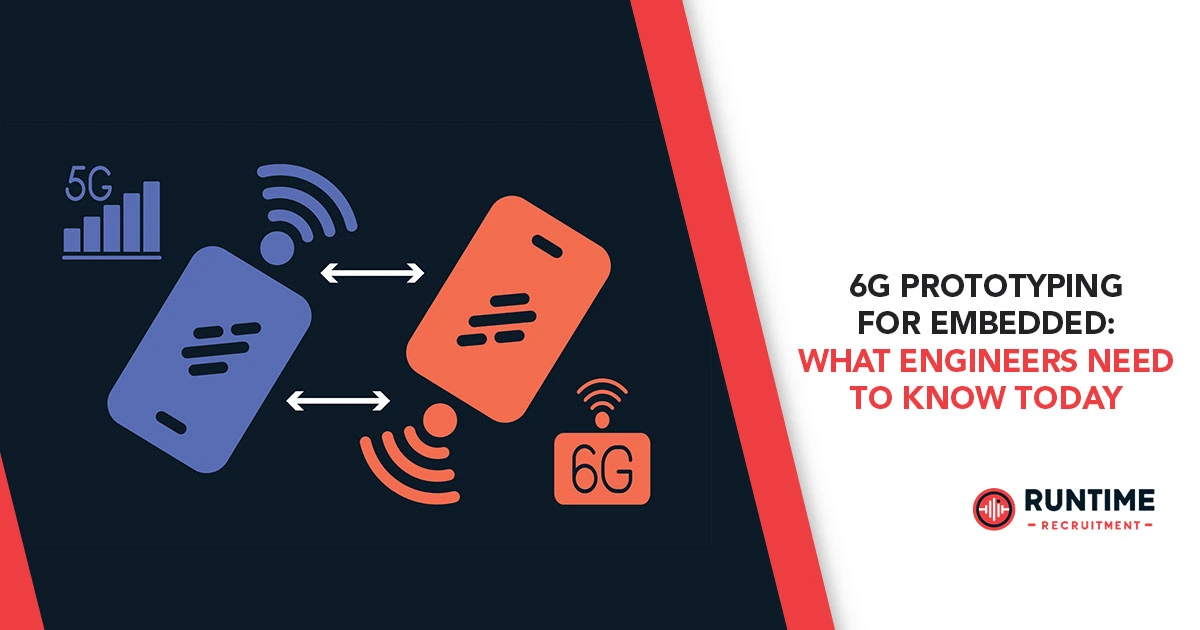While 5G is still rolling out globally, researchers and engineers are already looking ahead to 6G, the next generation of wireless communication. For embedded systems engineers, 6G presents both exciting opportunities and significant challenges.
Unlike previous generational shifts, 6G will not just be about faster speeds—it will integrate AI/ML-driven networks, terahertz (THz) frequencies, advanced beamforming, and ultra-low-latency communication for applications like holographic telepresence, autonomous swarm robotics, and brain-computer interfaces.
This article explores what embedded engineers need to know today about 6G prototyping, including:
- Key Differences Between 5G and 6G
- 6G’s Impact on Embedded Systems Design
- Prototyping Challenges for Embedded Engineers
- Tools and Platforms for Early 6G Development
- Use Cases Driving 6G Embedded Innovation
- How to Prepare for the 6G Transition
By understanding these aspects now, embedded engineers can position themselves at the forefront of 6G development.
1. Key Differences Between 5G and 6G
Before diving into embedded-specific challenges, it’s essential to understand how 6G differs from 5G:
| Feature | 5G | 6G (Projected) |
| Frequency Bands | Sub-6 GHz, mmWave (24-100 GHz) | Sub-THz (100 GHz – 1 THz) |
| Peak Data Rate | 20 Gbps | 1 Tbps (or higher) |
| Latency | 1 ms | < 0.1 ms (ultra-reliable) |
| AI Integration | Limited (network optimization) | End-to-end AI/ML-driven networks |
| Energy Efficiency | Moderate improvements | Radical improvements (10x+ lower power) |
| Key Use Cases | Enhanced mobile broadband, IoT | Holographic comms, smart surfaces, wireless brain-computer interfaces |
Why This Matters for Embedded Engineers
- Higher frequencies (THz bands) mean new RF front-end designs.
- Ultra-low latency requires real-time OS optimizations.
- AI/ML at the edge will demand more powerful embedded processors.
2. 6G’s Impact on Embedded Systems Design
Embedded systems will be at the heart of 6G devices, from base stations to wearables. Here’s how 6G will reshape embedded engineering:
A. Hardware Changes
- THz Transceivers: Current embedded RF modules (designed for 5G mmWave) won’t suffice. New III-V semiconductor (e.g., GaN, InP) and silicon photonics solutions will emerge.
- Energy Harvesting: 6G’s power demands may require ambient RF energy harvesting or advanced power management ICs (PMICs).
- Heterogeneous Compute: Expect AI accelerators (NPUs, TPUs) alongside traditional MCUs/MPUs.
B. Software & Firmware Challenges
- Real-Time OS Enhancements: Latencies below 100 µs will require deterministic scheduling (e.g., RT-Linux, Zephyr RTOS optimizations).
- AI/ML at the Edge: TinyML frameworks (TensorFlow Lite, MicroTVM) will need to run efficiently on resource-constrained devices.
- Security: Post-quantum cryptography and hardware-rooted trust will be mandatory.
C. Antenna & Beamforming Innovations
- Reconfigurable Intelligent Surfaces (RIS): Embedded controllers will dynamically steer THz beams using metamaterials.
- Phased Array Antennas: More compact, energy-efficient designs will be needed for wearables and IoT.
3. Prototyping Challenges for Embedded Engineers
Developing 6G-ready embedded systems today is challenging due to:
A. Lack of Mature Standards
- 6G standardization (expected by 2030) is still in early phases. Engineers must rely on research papers and early prototypes (e.g., from IEEE, 3GPP).
B. THz Signal Processing Difficulties
- Path loss at THz frequencies is extreme. Engineers must experiment with new materials and waveguide structures.
- ADC/DAC requirements will push beyond 100 GS/s, demanding novel mixed-signal designs.
C. Thermal & Power Constraints
- THz circuits generate significant heat. Engineers must explore liquid cooling, graphene heat spreaders, and advanced packaging.
D. Simulation & Testing Bottlenecks
- Traditional EDA tools (e.g., Cadence, Ansys HFSS) may struggle with THz modeling. Quantum computing-assisted EM simulations could become necessary.
4. Tools and Platforms for Early 6G Development
Despite the challenges, several tools can help embedded engineers experiment with 6G today:
| Tool/Platform | Use Case |
| MATLAB 6G Toolbox | Early PHY layer simulations |
| USRP X410 | Flexible SDR for THz experiments |
| Analog Devices ADMV1139 | mmWave/THz beamforming IC prototyping |
| Zephyr RTOS | Real-time embedded firmware development |
| Qorvo & Keysight THz Testbeds | Early 6G RF validation |
Open-Source Initiatives
- Open6G (by IEEE) – Collaborative 6G research platform.
- OpenAirInterface – Extending 5G NR for 6G experiments.
5. Use Cases Driving 6G Embedded Innovation
6G will enable applications that seem like science fiction today. Embedded engineers should watch these key areas:
A. Holographic Communications
- Embedded Requirements: Ultra-low-latency video processing (FPGA/ASIC-based encoders).
B. Autonomous Swarm Robotics
- Embedded Requirements: Distributed AI, THz-based mesh networking.
C. Wireless Brain-Computer Interfaces (BCI)
- Embedded Requirements: Sub-millisecond latency, biocompatible RF designs.
D. Smart Surfaces (RIS-Enabled Environments)
- Embedded Requirements: MEMS-based reconfigurable antennas.
6. How to Prepare for the 6G Transition
Embedded engineers can take proactive steps today:
- Experiment with mmWave/THz SDRs (e.g., USRP, LimeSDR).
- Learn AI/ML for Edge Devices (TinyML, federated learning).
- Explore Advanced Packaging Techniques (chiplets, 3D ICs).
- Join 6G Research Consortia (e.g., Next G Alliance, Hexa-X).
- Optimize for Energy Efficiency (near-threshold computing, spintronics).
Conclusion
6G is coming, and embedded engineers must start preparing now. While many technologies are still in the research phase, early prototyping efforts will define the success of next-gen wireless systems.
By understanding THz signal challenges, AI-driven networks, and ultra-low-latency requirements, embedded engineers can position themselves as leaders in the 6G revolution.









